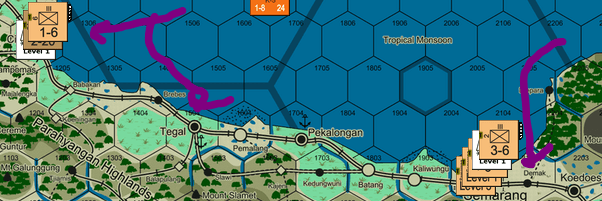the following is part one of a six part series executing a deep dive into the tsww system
[the second world war- diffraction games]
. this was GRACIOUSLY shared by a person FAMILIAR with GAME and the game system. it is a detail rich and image rich record of action spanning turns.. i hope you enjoy it as much as i did.
i took the liberty of breaking this 85mb beastie up into six parts that will be dropped each thursday for the next 6 weeks. our author has requested to remain ANONYMOUS.
This replay of the Invasion Java scenario from Singapore! is designed as a step-by-step introduction to various aspects of TSWW system. Moves and decision are not optimal; but all rolls of the dice are as they unfolded.
Situation
The Allies defend Java with a slender collection of ground assets — a few Dutch regiments and brigades reinforced by minor CW and US elements — the outmatched ABDA Fleet, and a mixed collection of air units. The Allies have a notable quantitative advantage in the air.
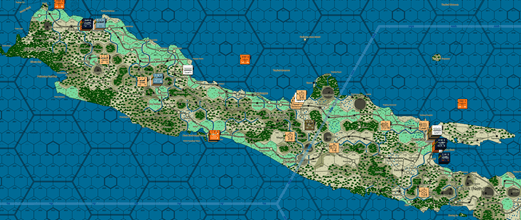
We’ll take a look at each sector in more detail. In the East, around Soerabaja, the equivalent of a regiment guards the town, with coastal defenses. The main US Airbase is here, along with most of the Allied fleet. Another regiment guards Semarang on the Java north coast and other cities:
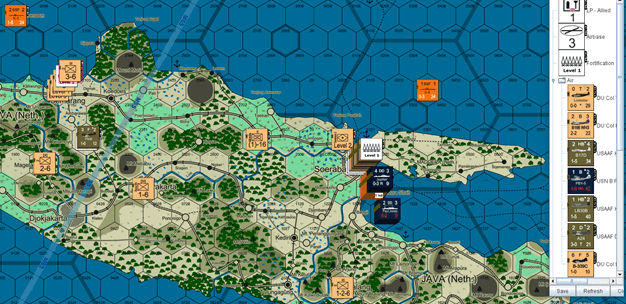
The fleet at Soerabaja includes CA Houston CA Exeter CL Perth the two Dutch CLs, and a bunch of DDs and other craft. Houston starts with a hit. Subs guard the approach to the port and the North Coast.
In the West, a smaller naval detachment bases at Batavia (2 CLs, DDs, DEFs), also held by a regiment. Substantial air assets are based inland at Bandoeng (shown in the stack viewer below). A garrison of British and Dutch troops is based at the small port of Cirebon on the north coast. Tjilatjap, on the south coast, has recon and minor naval assets:
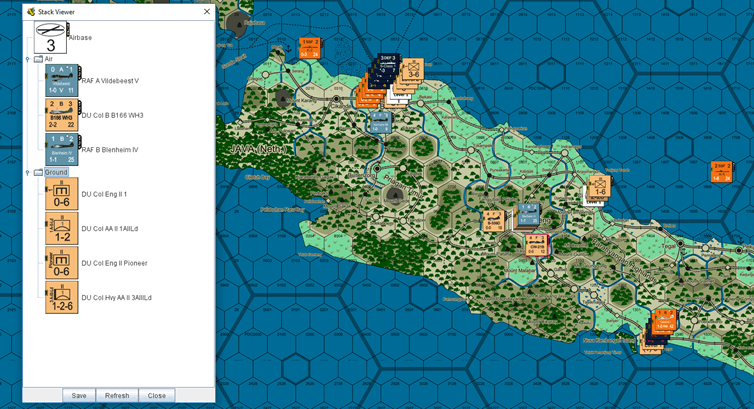
ABDA forces at Tjilatjap; Dutch and US assets:
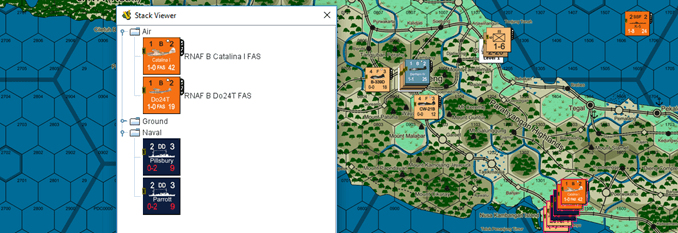
ABDA command does not know where the Japanese will land, but strongly suspects the north coast, from which Japan can strike either East or West.
The Japanese forces are organized into a Western (left below) and Eastern (right below) set of NTGs. Each force includes a forward heavy cruiser force (the NTF) and a Convoy containing the landing force. The Western force not only has more cruisers, but also carrier cover in the former of the CVL Ryujo.
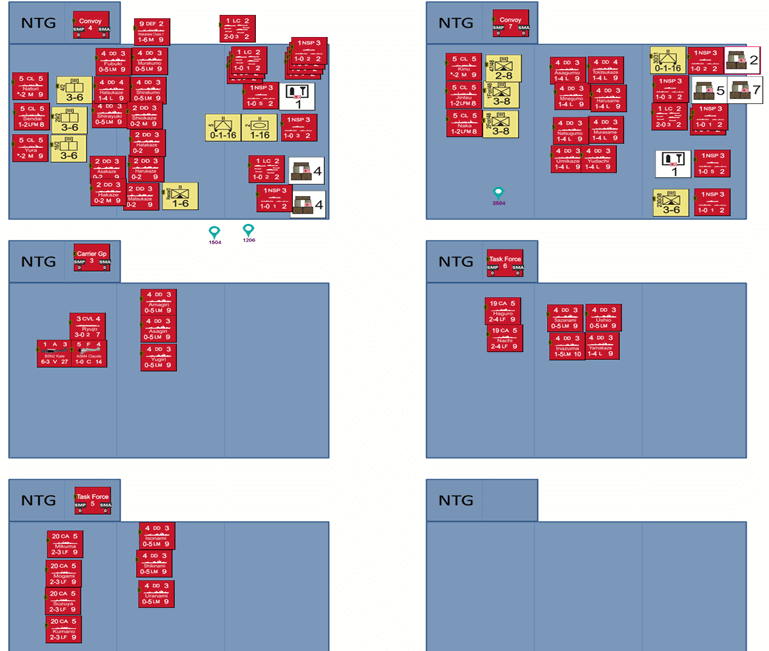
A word on the organization of the landing forces (Convoys 4 and 7). The Japanese need to carry all the supplies the ships can hold. Thus, warships are impressed to carry troops for the landing, which ultimately will transfer to LCs. Each DD can carry 0.25 stacking points, and a major combatant 0.5 (see 9.J.3.d). Thus, in some cases, Cruisers are carrying a regiment. LCs could move on their own, but have their fuel (SMA) cut 2/3ds when they do; thus, they most are carried by NSPs (2 NSPs per LC). See Rule 9.K.2. When landing non-amphibious forces, each LC can land 0.5 SPs. Thus, the Western force, with 3 regiments to land in the initial wave, will bring 6 LCs along. 3 will join the Eastern force and help land the 3 regiments there. All spare LCs/NSPs otherwise carry supplies. 5 NSPs can carry 1 LP or 20 GSPs (each GSP is 0.25 SP; each NSP carries 1 SP). Japan prefers to keep LPs where it can for now (they may be broken down into 20 GSPs), but some GSPs as well are on the transports, to take advantage of all available space. Note the motorized AA battalion and tanks are 3x cost and thus take 1.5 NSP/battalion – expensive to bring (with motorized infantry, can leave trucks behind for reduced shipping cost; not an option here). Warships do not carry supplies because, per the revised rules recently posted on the Yahoo Group list, they become far more vulnerable to enemy action when ferrying GSPs. [Note: Not pictured above is a Mn. Corps HQ (16th) with E TF – very important for Japan for Offensive Supply once landed]:
The Japanese forces begin at some distance from their objectives, with some supporting air assets. The Western force and supporting assets (float-plane carrier in the upper right in Singkawang); army air assets in Sumatra in the lower left. The cruiser force (TF5) is out in front, followed by the carriers and finally Convoy 4.
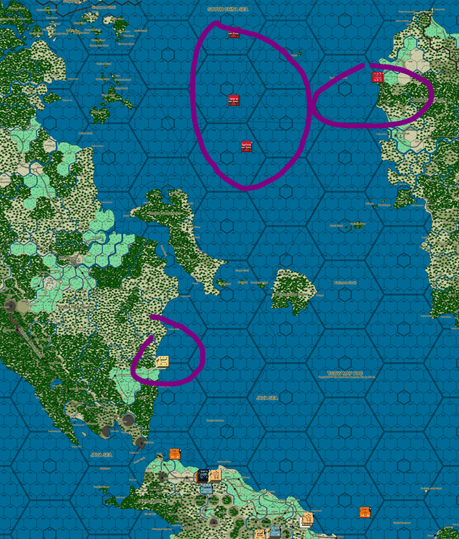
Meanwhile, the Eastern Task Force (Convoy 7 and TF 6) are off Borneo, with long-range supporting IJN assets, including Zeros and Betty naval bombers:
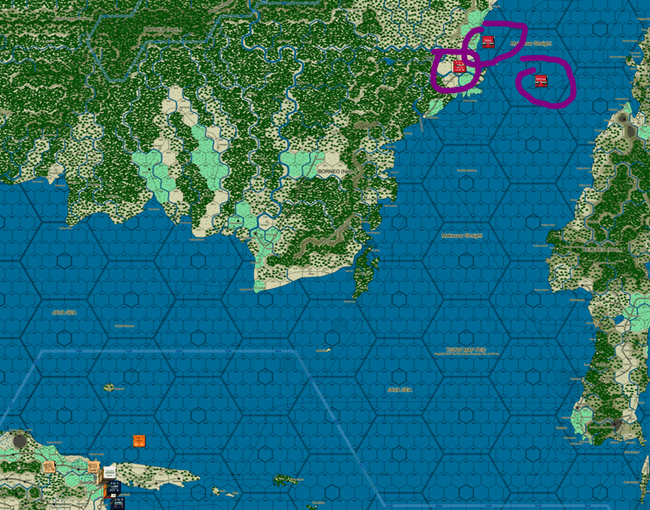
The Japanese plan is to land adjacent to Semarang with the Eastern TF, to take Cirebon and Tegal with the Western TF, and then defeat the Allies in detail, dealing with the Eastern and Western forces in turn:
